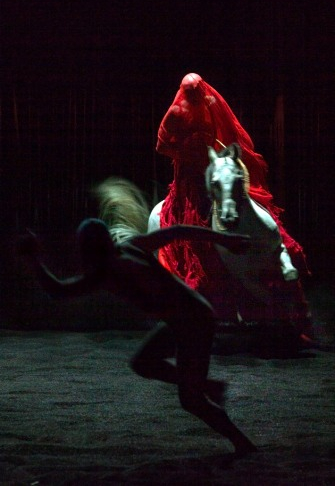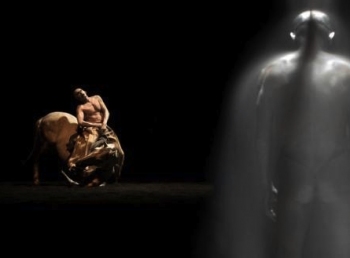The Centaur and the Animal, Sadler's Wells | reviews, news & interviews
The Centaur and the Animal, Sadler's Wells
The Centaur and the Animal, Sadler's Wells
Unforgettable theatrical imagery with horse and man and the theme of death
To achieve a black stage that emits or reflects no light is a hell of an achievement. To place a huge black horse with black rider onto that stage, without the slightest noise, and to contrive a black shadow on the black, is to create an image found in the fathomless wells of subconscious imagery, and the skill of that vision and realisation of it is something I doubt I'm going to forget.
The Centaur and the Animal is a very strange and potent piece of theatre at Sadler’s Wells this week uniting - if it were possible - the pessimism of Japanese butoh dance-theatre with the mystical grandeur of the rider on the horse, and the great and fearsome associations between them. The mythology of horses remains barely noticed in theatre, so difficult is it to put them on stage without being gimmicky, but the show's conceiver, Bartabas, has a phenomenal equestrian mastery and the imaginative power to use it.
 However, you can tell he's French. I’d call this a thrilling theatrical event if it weren’t for it being saddled (sorry) with a heavily distracting and blowsy voiceover of verbiage poétique. The problem is less the quality of the text, than that to listen to it intelligently fights the non-verbal senses required to process the images, and therefore the power of the event was - for me - ripped down the middle like a piece of paper torn in two.
However, you can tell he's French. I’d call this a thrilling theatrical event if it weren’t for it being saddled (sorry) with a heavily distracting and blowsy voiceover of verbiage poétique. The problem is less the quality of the text, than that to listen to it intelligently fights the non-verbal senses required to process the images, and therefore the power of the event was - for me - ripped down the middle like a piece of paper torn in two.
Words are murmured from first till last, a text oozing with images of sickness, corruption and decay. The English is not well enunciated and has enough of an accent to be a trial just to listen to through the patchy sound system. Swiftly giving up, I decided to ignore it and simply to blot up the extraordinary images and Jean Schwarz’s electronic noise soundscore. It worked for me, though I am told by colleagues who could hear better that the extracts of Lautréamont’s 1869 Les chants de Maldoror contained divertingly lurid images of vipers swallowing pricks, crabs in anuses, carbuncles, testicles, and all sorts of dactylic deliciousness.
Be that as it may, I was drawn down, down, down into this unnerving unreality, as Ko Murobushi, a tiny wiry old man, crawled and wriggled blindly and in extreme slow motion on the chalk-white frontage of the stage, while behind him in the sightless black vacuum Bartabas rode his horses like shadows of death.
The black-white contrast is somehow entirely lifeless, an impression paradoxically enhanced by the electronic fragments of drips, voices, echoes, last memories from the world. Powdered floors ensure not the slightest reflectivity or noise, on black or white. The stage is closed in with draped black curtains that can catch a fleck of light and undulate slipperily, like the gaping mouth walls of the Leviathan, or which disappear into nothing, leaving one in tomblike blackness, total absence of light, total disconnection with life.
Murobushi appears to be dreaming of approaching death, confronting the charging horseman of death in his fantasy, freezing in agonies of fear in reality. His little body is painted silver, and when at some point he upends himself naked on stage in a shoulder-stand, his head invisible from the front, it’s a terrible vision, a pewter statue of a man thrown like a dart into the white ground, petrified, headless, eyes underground. And behind him, in the black beyond, waits a shadowy centaur ready to collect his corpse, or a white, hooded Mongol khan on a magnificant, bull-necked warhorse.
 Bartabas melds into his steeds in shifting waves of materials, like cobwebs, shrouds or gigantic black wings. Sometimes his body seems to vanish and the horse appears riderless, borne on wings. Sometimes he is a man dying with his horse, collapsing over and over while Murobushi shivers under a shower of dust (pictured left). The images are broken out separately, stark enough and blurry enough in the darkness to draw each viewer to their own line of thought.
Bartabas melds into his steeds in shifting waves of materials, like cobwebs, shrouds or gigantic black wings. Sometimes his body seems to vanish and the horse appears riderless, borne on wings. Sometimes he is a man dying with his horse, collapsing over and over while Murobushi shivers under a shower of dust (pictured left). The images are broken out separately, stark enough and blurry enough in the darkness to draw each viewer to their own line of thought.
The stage is designed and lit by geniuses, the four horses - only seen singly, which creates a strange shape-shifting effect - are marvels of discipline, their deployment by Bartabas of solemn and disturbing iconography. Although, to be sure, Murobushi has some achingly slow passages involving sand or pianos, when one does mentally check through the things that need doing tomorrow (and several punters left early), this is the first time in my experience that these miraculous beasts have been done justice on stage.
- The Centaur and the Animal is at Sadler's Wells till Sunday, 6 March
- See what's on at Sadler's Wells. Read Sadler's Wells show reviews
Explore topics
Share this article
Add comment
more Dance
 All You Need Is Death review - a future folk horror classic
Irish folkies seek a cursed ancient song in Paul Duane's impressive fiction debut
All You Need Is Death review - a future folk horror classic
Irish folkies seek a cursed ancient song in Paul Duane's impressive fiction debut
 MacMillan Celebrated, Royal Ballet review - out of mothballs, three vintage works to marvel at
Less-known pieces spanning the career of a great choreographer underline his greatness
MacMillan Celebrated, Royal Ballet review - out of mothballs, three vintage works to marvel at
Less-known pieces spanning the career of a great choreographer underline his greatness
 Carmen, English National Ballet review - lots of energy, even violence, but nothing new to say
Johan Inger's take on Carmen tries but fails to make a point about male violence
Carmen, English National Ballet review - lots of energy, even violence, but nothing new to say
Johan Inger's take on Carmen tries but fails to make a point about male violence
 WAKE, National Stadium, Dublin review - a rainbow river of dance, song, and so much else
THISISPOPBABY serves up a joyous tapestry of Ireland contemporary and traditional
WAKE, National Stadium, Dublin review - a rainbow river of dance, song, and so much else
THISISPOPBABY serves up a joyous tapestry of Ireland contemporary and traditional
 Swan Lake, Royal Ballet review - grand, eloquent, superb
Liam Scarlett's fine refashioning returns for a third season, and looks better than ever
Swan Lake, Royal Ballet review - grand, eloquent, superb
Liam Scarlett's fine refashioning returns for a third season, and looks better than ever
 First Person: Ten Years On - Flamenco guitarist Paco Peña pays tribute to his friend, the late, great Paco de Lucía
On the 10th anniversary of his death, memories of the prodigious musician who broadened the reach of flamenco into jazz and beyond
First Person: Ten Years On - Flamenco guitarist Paco Peña pays tribute to his friend, the late, great Paco de Lucía
On the 10th anniversary of his death, memories of the prodigious musician who broadened the reach of flamenco into jazz and beyond
 Dance for Ukraine Gala, London Palladium review - a second rich helping of international dancers
Ivan Putrov's latest gala was a satisfying mix of stars and young hopefuls
Dance for Ukraine Gala, London Palladium review - a second rich helping of international dancers
Ivan Putrov's latest gala was a satisfying mix of stars and young hopefuls
 Nelken: A Piece by Pina Bausch, Sadler's Wells review - welcome return for an indelible classic
A new generation of gifted performers for us to get to know
Nelken: A Piece by Pina Bausch, Sadler's Wells review - welcome return for an indelible classic
A new generation of gifted performers for us to get to know
 Dark With Excessive Bright, Royal Ballet review - a close encounter with dancers stripped bare
The Royal's Festival of New Choreography launches with an unforgettable walk in the dark
Dark With Excessive Bright, Royal Ballet review - a close encounter with dancers stripped bare
The Royal's Festival of New Choreography launches with an unforgettable walk in the dark
 La Strada, Sadler's Wells review - a long and bumpy road
Even the exceptional talents of Alina Cojocaru can't save dance adaptation of Fellini film
La Strada, Sadler's Wells review - a long and bumpy road
Even the exceptional talents of Alina Cojocaru can't save dance adaptation of Fellini film
 First Person: pioneering juggler Sean Gandini reflects on how the spirit of Pina Bausch has infiltrated his work
As Tanztheater Wuppertal Pina Bausch's 'Nelken' comes to Sadler’s Wells, a tribute from across the art forms
First Person: pioneering juggler Sean Gandini reflects on how the spirit of Pina Bausch has infiltrated his work
As Tanztheater Wuppertal Pina Bausch's 'Nelken' comes to Sadler’s Wells, a tribute from across the art forms
 Manon, Royal Ballet review - a glorious half-century revival of a modern classic
Fifty years on, Kenneth MacMillan's crash-and-burn anti-heroine is riding high
Manon, Royal Ballet review - a glorious half-century revival of a modern classic
Fifty years on, Kenneth MacMillan's crash-and-burn anti-heroine is riding high

Comments
...
...
...